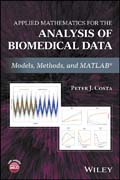
Applied mathematics for the analysis of biomedical data: models, methods, and MATLAB
Costa, Peter J.
Features a practical approach to the analysis of biomedical data via mathematical methods and provides a MATLAB® toolbox for the collection, visualization, and evaluation of experimental and real–life data Applied Mathematics for the Analysis of Biomedical Data: Models, Methods, and MATLAB® presents a practical approach to the task that biological scientists face when analyzing data. The primary focus is on the application of mathematical models, and scientific computing methods for data to provide insight into the behavior of biological systems. The author draws upon his experience in academia industry, and government sponsored research as well as his expertise in MATLAB to produce a suite of computer programs with applications in epidemiology, machine learning, and biostatistics. These models are derived from real–world data and concerns. Among the topics included are the spread of infectious disease (HIV/AIDS) through a population, statistical pattern recognition methods to determine the presence of disease in a diagnostic sample, and the fundamentals of hypothesis testing. In addition, the author uses his professional experiences to present unique case studies whose analyses provide detailed insights into biological systems and the problems inherent in their examination. The book contains a well–developed and tested set of MATLAB functions that act as a general toolbox for practitioners of quantitative biology and biostatistics. This combination of MATLAB functions and practical tips ampli— es the book s technical merit and value to industry professionals. Through numerous examples and sample code blocks, the book provides readers with illustrations of MATLAB programming. Moreover, the associated toolbox permits readers to engage in the process of data analysis without needing to delve deeply into the mathematical theory. This gives an accessible view of the material for readers with varied backgrounds. As a result, the book provides a streamlined framework for the development of mathematical models, algorithms, and the corresponding computer code. In addition, the book features: Real–world computational procedures that can be readily applied to similar problems without the need for keen mathematical acumen Clear delineation of topics to accelerate access to data analysis A Solutions Manual containing solutions to select exercises and a related website containing the MATLAB toolbox created for this book Applied Mathematics for the Analysis of Biomedical Data: Models, Methods, and MATLAB® is an excellent textbook for students in mathematics, biostatistics, the life and social sciences, and quantitative, computational, and mathematical biology. This book is also an ideal reference for industrial scientists, biostatisticians, product development scientists, and practitioners who use mathematical models of biological systems in biomedical research, medical device development, and pharmaceutical submissions. PETER J. COSTA, PhD, is Senior Applied Mathematician at Hologic Incorporated in Marlborough, MA. Dr. Costa is the co–creator of MATLAB?s Symbolic Math Toolbox. He has developed mathematical models for the spread of HIV, the outbreak of AIDS, the transmission of an infectious respiratory disease throughout a population, and the diagnosis of cervical cancer. His research interests include scientific computing and mathematical biology. He received a PhD in Applied Mathematics from the University of Massachusetts at Amherst. INDICE: Preface .Acknowledgements .In Memoriam .In Dedication .Introduction .Chapter 1: Data .1.1. Data Visualization .1.2. Data Transformations .1.3. Data Filtering .1.4. Data Clustering .1.5. Data Quality and Data Cleaning .References .Chapter 2: Some Examples .2.1. Glucose Insulin Interaction .2.2. Transition from HIV to AIDS .2.3. Real Time Polymerase Chain Reaction .References .Chapter 3: SEIR Models .3.1. Transmission of HIV/AIDS .3.2. Modelling the Transmission of a Respiratory Epidemic .3.3. Predicting the Outbreak of a Respiratory Epidemic .References .Additional References (HIV/AIDS) .Chapter 4: Statistical Pattern Recognition and Classification .4.1. Measurements and Data Classes .4.2. Data Preparation, Normalization, and Weighting Matrix .4.3. Principal Components .4.4. Discriminant Analysis .4.5. Regularized Discriminant Analysis and Classification .4.6. The Confusion Matrix, Receiver Operator Characteristic Curves, and Assessment Metrics .4.7. An Example .4.8. Nonlinear Methods .References .Chapter 5: Biostatistics and Hypothesis Testing .5.1. Hypothesis Testing Framework .5.2. Test of Means .5.3. Tests of Proportions .5.4. Tests of Variances .5.5. Other Hypothesis Tests .References .Chapter 6: Clustered Data and Analysis of Variance .6.1. Clustered Matched pair Data and Non inferiority .6.2. Clustered Data, Assessment Metrics, and Diagnostic Likelihood Ratios .6.3. Relative Diagnostic Likelihood Ratios .6.4. Analysis of Variance for Clustered Data .6.5. Examples for ANOVA .6.6. Bootstrapping and Confidence Intervals .References .Appendix: Mathematical Matters .Glossary of MATLAB Functions .Index
- ISBN: 978-1-119-26949-6
- Editorial: John Wiley
- Encuadernacion: Tela
- Páginas: 440
- Fecha Publicación: 01/04/2017
- Nº Volúmenes: 1
- Idioma: Inglés
